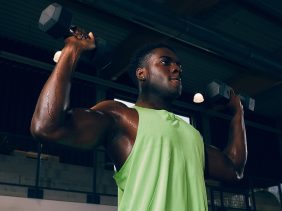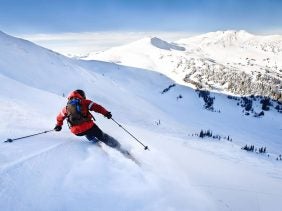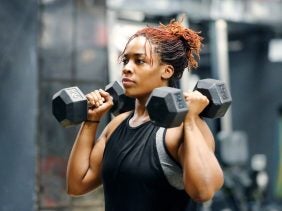How to do air squats right for maximum results – and 5 fresh variations
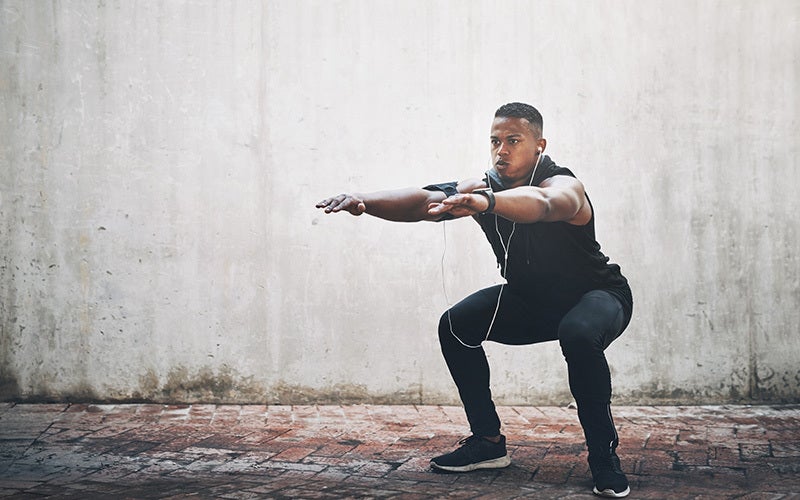 ©PeopleImages
©PeopleImages
Air squats, bodyweight squats, or the “#1 exercise.” No matter what you call it, it’s one of the most popular and effective exercises in amateur and competitive sports. But you’re only going to strengthen your legs and firm up your glutes if you do it right.
What are Air Squats?
Squats aren’t a new exercise created just for fitness and strength training. This movement is both natural and age-old: in the past, it was a common position for people to eat or rest in. If you observe how children move, you’ll see this kind of deep knee bend is no problem for them. They can sit and play in a squat position all day.
Through the shift from active to sedentary lifestyles, we’ve largely lost this ability to sit in a deep squat. So it’s definitely for the best that knee bends have become an integral part of routines for fitness and competitive sports.
As its other name suggests, in air squats you bend your knees to go from an upright position to a squatting position. After that, you push yourself up again using the power of your leg muscles.
Air squats involve all your large muscle groups: In addition to your legs and glutes, you’re also exercising and strengthening your core. Air squats are not only considered to be real muscle makers, but are also known as calorie burners due to their extensive use of your muscles.
Depending on your fitness goal, fitness level, equipment available, pre-existing conditions, and personal preferences, there are countless options for working out with squats. But the basic move that everything starts with is the air squat / bodyweight squat – a squat that only uses your own body weight.
Check this out: Ready to get started? With our free foodspring workouts, tailored to your goals and your fitness level, you can train effectively toward your goals at home. You decide: There’s tons of different workouts to choose from!
Which Muscles do Air Squats Train?
Air squats are in the compound exercises category. In contrast to isolation exercises, they use and train several muscles at once. Air squats strengthen almost all your muscles, with a focus on the thighs, glutes, and torso.
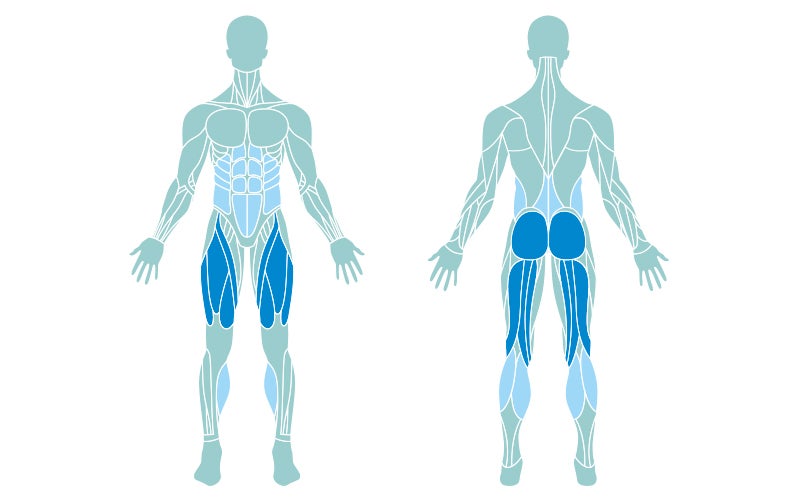
- ©foodspring
Primary muscles trained / used:
- Musculus quadriceps femoris / knee extensor / quads: The 4-headed leg extensor is responsible for extending the knee. Even in air squats with “just” your own body weight, the thigh has to work hard to get you up from a squat – to extend your legs again.
- Ischiocrural musculature / posterior thigh muscles / hamstrings: The ischiocrural musculature is responsible for bending the knee and extending the hip. It “forces” you into the bend during an air squat. The hamstrings consist of the following muscles:
- Biceps femoris / hip bender / knee flexor: flexes the knee; extends the hip; turns the knee slightly outwards while bending;
- Musculus semitendinosus / “half-tendon” muscle: flexes the knee; extends the hip; turns the leg slightly inwards while bending;
- Musculus semimembranosus / “membranous tendon” muscle / semimembranous muscle: flexes the knee; extends the hip; turns the lower leg inwards while bending. During free-standing exercises, like air squats, all 3 muscles must be coordinated in order to keep the lower leg stable, and to prevent simultaneous outer and inner rotation.
- Gluteus maximus muscle / buttock muscle: During the squat, the gluteus maximus muscle moves the leg away from the center of the lower body. It also rotates the leg slightly outwards. Since the gluteus maximus muscle also takes care of the extension of the hip, air squats are a perfect workout for it.
Secondary muscles trained/used:
- Musculus erector spinae / back extensor: The function of the back extensor is to straighten the back, or keep it straight, during air squats.
- Frontal and lateral abdominal muscles: The frontal and lateral abdominal muscles support the back extensor in keeping the upper body straight and stable during air squats.
Fun fact: A Brit named Paddy Doyle holds the world record for air squats – on November 8th, 2007, he managed 4,708 air squats in one hour.
How to Air Squat
No squat is the same as another. They depend not only on your mobility, physique, and the type of squat, but also on whether you’re doing it right or not!
You’re in a complete squat when your buttocks and heels are on the same level (aka: “ass to the grass”). The foundation of a good air squat is achieving tension in all leg joints and holding them steady throughout the exercise.
Starting position:
- Standing upright, looking straight ahead.
- Stance depends on goal and range of mobility. You can stand with your feet hip width or shoulder width. Shoulder width is the most common stance, and can be used in many other movements in workouts and competitive sports.
- Body weight distributed over the whole foot in a 3-point stance. The foot’s natural arch automatically leads to a 3-point stance (heel – outer edge – big toe). If this ideal foot position cannot be reached or maintained, you’ll lose stability and strength.
- Feet can be parallel or turned slightly outwards, depending on their flexibility. Think: “slight V-position”; “turn into the ground”; “lemon squeeze”.
- Knees are slightly bent.
- Arms hang loosely by your sides.
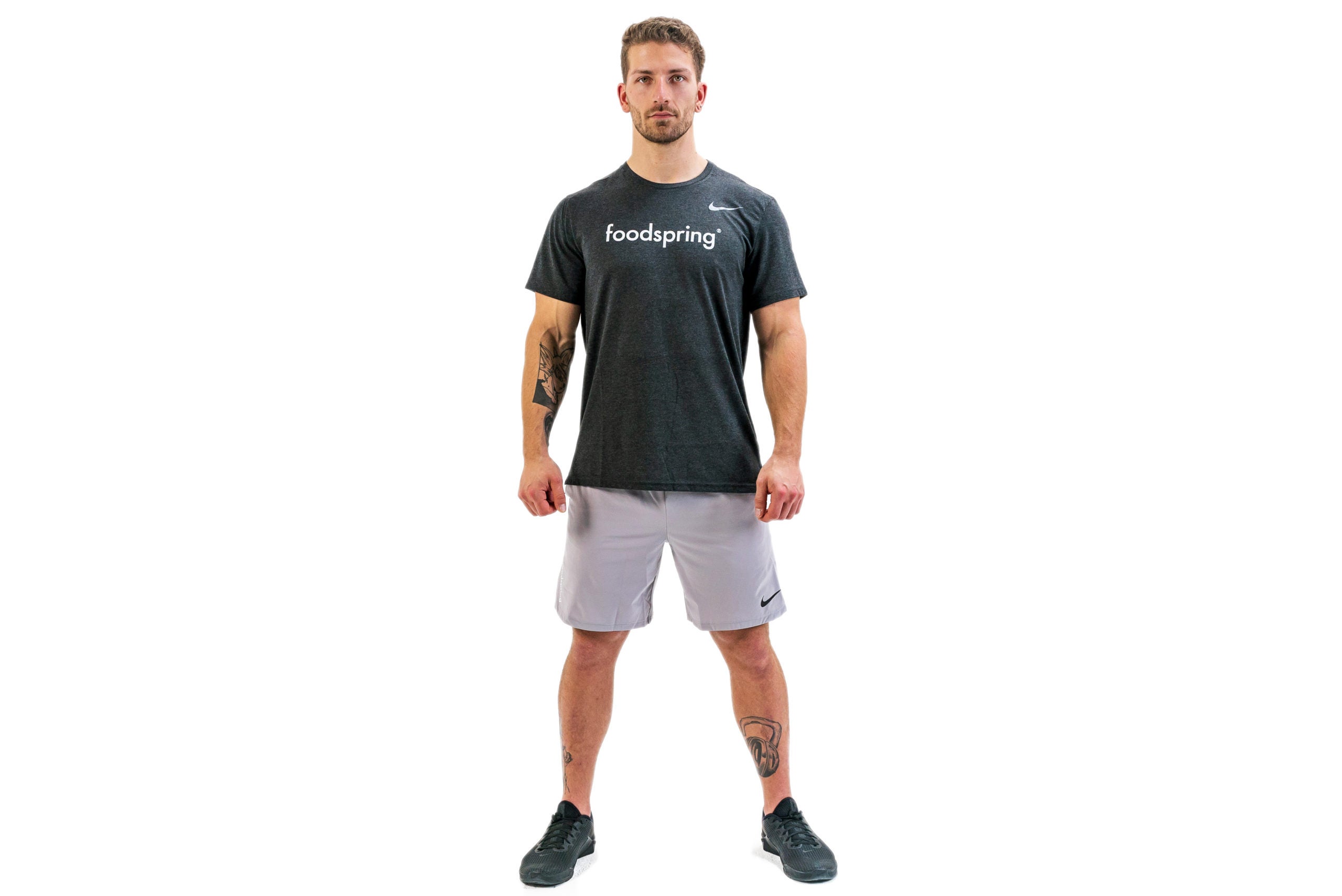
- ©foodspring
Execute a squat correctly / Step-by-step
- Lower the back of your thighs down and back.
- Point your chest straight ahead and not to the floor.
- Tense the muscles in your torso.
- Breathe in as you bend your legs. Pull your shoulders down with the movement, and move your arms forward. Turn your thumbs inwards.
- Keep knees neutral, i.e. they always move up and down on the same level.
- Knees point in the same direction as your toes.
- Go only as low as you can maintain stability, balance, and tension. Tilt your torso forward slightly when you lower it.
- At your lowest point, push yourself up again using your leg muscles.
- Breathe out while lifting up.
Hard truths: The depth of your squat depends not only on your mobility, agility, flexibility, execution, strength, and motor control, but also on how you’re built. Due to the different lengths of various body parts (thighs in particular), not everyone has the same range in their joints.
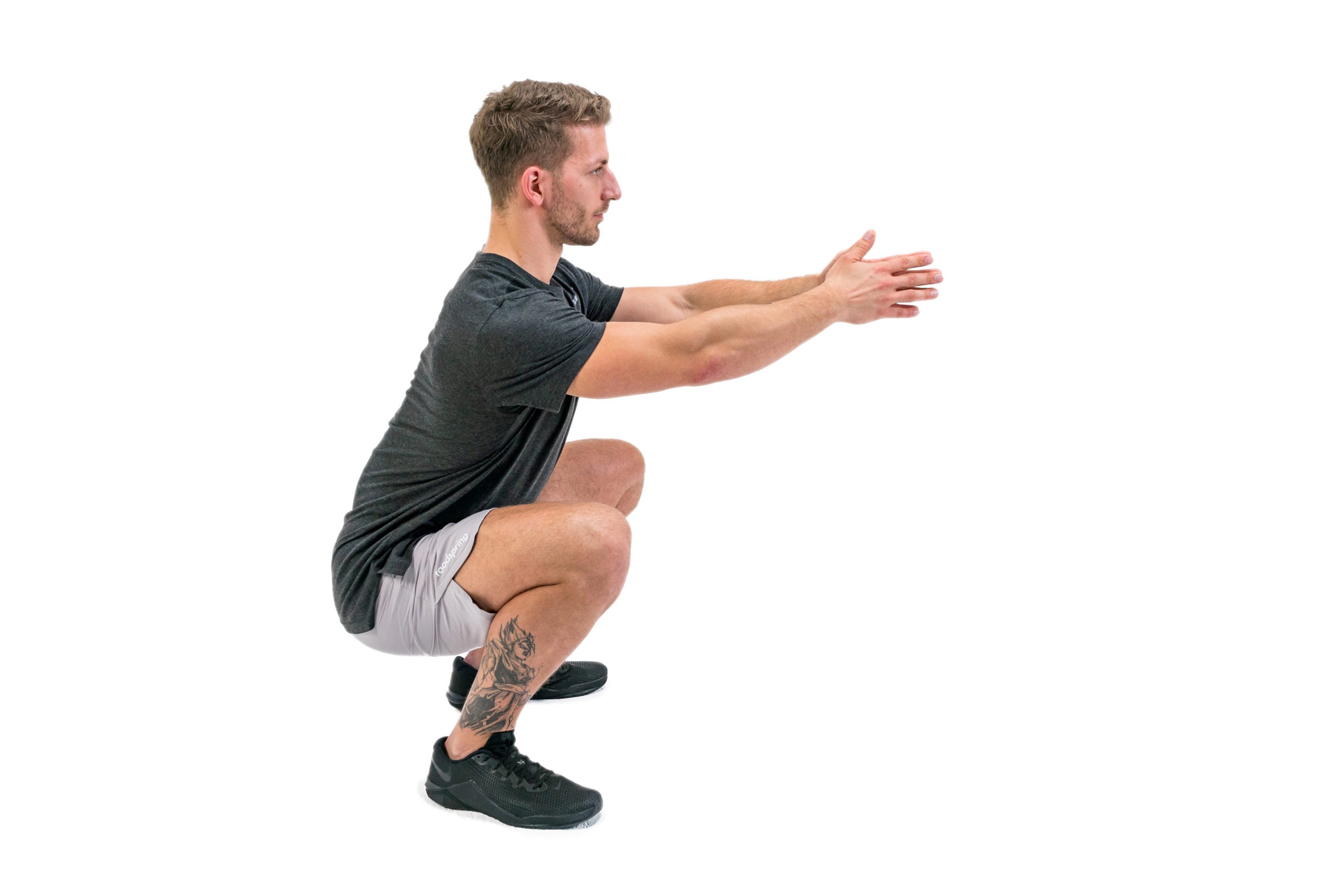
- ©foodspring
Common Mistakes and How to Avoid Them! Tips and Tricks
#1 Starting with your knees
A common mistake in all kinds of air squats is beginning the movement by bending and pushing the knees forward. This makes the load on them particularly high.
Our tip: Imagine you wanted to sit down on a chair. You wouldn’t land on it if you pushed your knees forward! For the first few centimeters of the exercise, concentrate on pushing the back of your thighs down and to the rear. Keep your legs pointing out and your shins as upright as possible. Tense your core muscles and keep your torso upright.
#2 Knees falling in – “knock knees”
One frequently observed avoidance or compensatory movement is the so-called “inward collapsing knee”. If your knees fall in during an air squat, it may be due to other causes than how your legs are aligned (knock knees). Knees tend to collapse inwards during the upward phase in particular. Some causes include too much weight, abductors that are too weak, a stance that’s too wide or too narrow, a lack of concentration or control, or limited mobility in the ankle joints. Squats are one of the most complex exercises, so it takes time, patience, and a lot of practice to master them accurately.
Our tip: If you collapse inwards, check your lower body stance. Turn your toes into the ground so that your knees are facing outwards. Knees point in the direction of your toes. Use a little less weight and deliberately push your legs outwards when you come up to maintain your form. Move your ankles in circles regularly, especially before going into air squats.
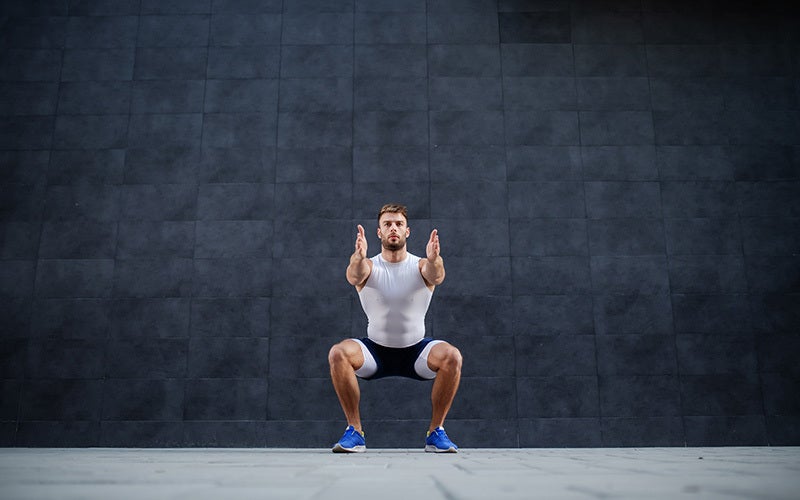
- ©dusanpetkovic
#3 Rounded back / head craned back / butt wink and similar.
If you’re concentrating too much on your lower body, you’ll forget your upper body. Usually it’s your head that’ll fall back or you’ll neglect the tension in your upper back.
Our tip: Keep your gaze straight ahead and your spine straight. Drop your shoulders. Contract your latissimus (lats, mid-back muscle).
And what about the butt wink? The butt wink usually occurs during the downward movement in deep squats. In a butt wink, the spine is no longer in its natural position at the lowest point of the movement. The lumbar spine curves under and the pelvis is pressed forward and under.
The causes and effects of butt winks are disputed.
What we know for sure is that anatomical factors prevent flexion in the hip at a certain angle so an evasive movement begins in order to keep going as deep as possible, i.e. “ass to the grass.” In addition, a lack of control and muscular weakness in the dorsal extensor can lead to a rounding of the lumbar spine. It’s unlikely that “shortened” hamstrings (back of the thigh) could also be “to blame.” A measurable change in hamstring length while the knee bends is almost non-existent. Therefore, the pelvis cannot “be pulled under.” Finally, a lack of mobility in the ankle joints could also trigger a butt wink. If the knees cannot move further forward during the squat, the pelvis must tilt to prevent a loss of balance.
Whether or not this butt wink can cause physical problems depends on the type of squat; the physical stress level is very low in an air squat, so it’s recommended that you use your full range of motion (exception: pain, back problems, previous injuries). To protect your lower back, however, a butt wink should be avoided when training with weights.
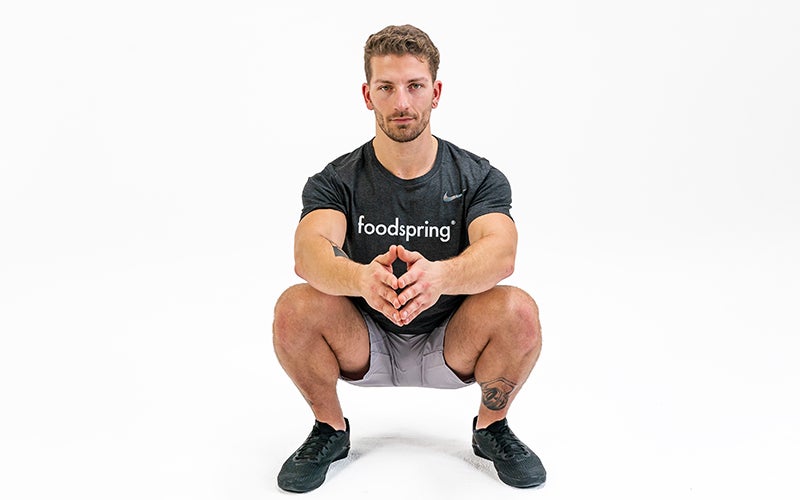
- ©foodspring
Our tip: Warm up your ankle joints before working out, if necessary you can work with a lift under your heels. Strengthen your back extensor muscles regularly. You can do a few repetitions of back extensor isolations before your air squats to build up some tension and awareness. Don’t overextend your lower back, train with appropriate weights, and only go as low as you can while keeping tension in your back.
Side note: How deep should you go into a squat? 90° in the knee or “ass to the grass”? Squats should only go up to a 90° angle – everything else is harmful! Right? Wrong! No matter what exercise it is, to train efficiently and effectively, you should use your full range of motion. In addition, the load is at its highest on the knee at 90%. If there are no health restrictions, go as deep as you can, as long as you can continue the movement in a controlled and clean way.
#4 Heels lift off the ground
If your heels lift off the ground, you should focus on improving your ankle mobility. Distribute your weight over the whole foot (3-point stance) and put your arms in front of you during each repetition.
What Are Squats Good For?
Squats have many positive effects on your health! In addition to their similarity to everyday movements, their complexity, and the multiple joints involved, they:
- Build muscle in the legs and glutes
- Six-pack through squats? Air squats strengthen your entire torso, delivering optimal six-pack training in addition to leg training
- Burn a high number of calories, due to the large number of muscles used
- Zap fat
- Train and improve stability and coordination
- Improve the cardiovascular system and increase your general fitness level
- Help maintain joint cartilages in the hip, knee, and ankle joints
- Prevent joint problems (especially knee joint)
- Increase knee stability
- Improve sprint and jump performance
Our tip: You need some fresh energy right after working out! Our high-quality Whey Protein is an optimal solution since it’s an easy-to-access protein and energy supply.
How many calories do you burn with squats?
Squats are definitely calorie burners because of the large number of muscles involved and the many options for variation and increased difficulty. However, an exact number of calories burned is difficult to determine. The calories burned in air squats varies from individual to individual and depends on various factors, such as age, size, gender, total amount of exercise, workout intensity, and workout duration.
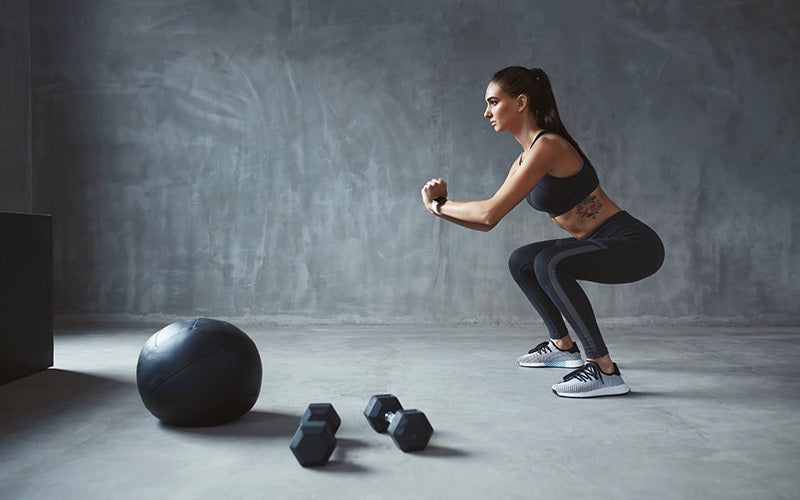
- ©puhhha
How many squats should you do per day?
First you have to decide on the type of squats and your goal. Doing squats with heavy weights? Give yourself, and your lower body especially, enough time to regenerate after a training session. With air squats it’s different: You can do these squats without weights every day, to support mobility and maintain cartilage. But even with air squats you should be careful to not go too far: Take a break as soon as you notice sore muscles or pain. You don’t increase your muscle mass during a workout, but in the recovery phase afterwards instead. Anyone who does a few bodyweight squats every day does something for their health and fitness. But remember: everything in moderation! Listen to your body. 300 air squats per day, even without extra weight, might be too much!
Air Squats
Sumo Air Squats:
In sumo air squats, the stance is wider than shoulder width. Tips of the toes and knees are turned outwards. This wide stance activates the inner sides of the thighs (adductors) more. Sumo air squats are perfect for beginners, because the wider stance is more stable and helps you maintain tension and balance.
Pistol (Squats):
Pistol squats are one-legged deep squats. This exercise is very demanding and requires a high degree of mobility, coordination, and strength. When standing, one leg is stretched forward and kept straight while lowering down and lifting up. Press your standing leg firmly into the floor and use your arms to keep your balance.
Crab Walk Squat:
Also known as side-step squat or monster walk. The starting point is a normal squat. While holding this position in the deep squat, step to the side with your right/left leg. The tension and depth of the squat must be maintained. Turn your feet and legs slightly outwards when stepping outwards. Afterwards you go the other way with the other leg. You can do this exercise either in motion, i.e. move a certain distance and then go back, or by staying in one place.
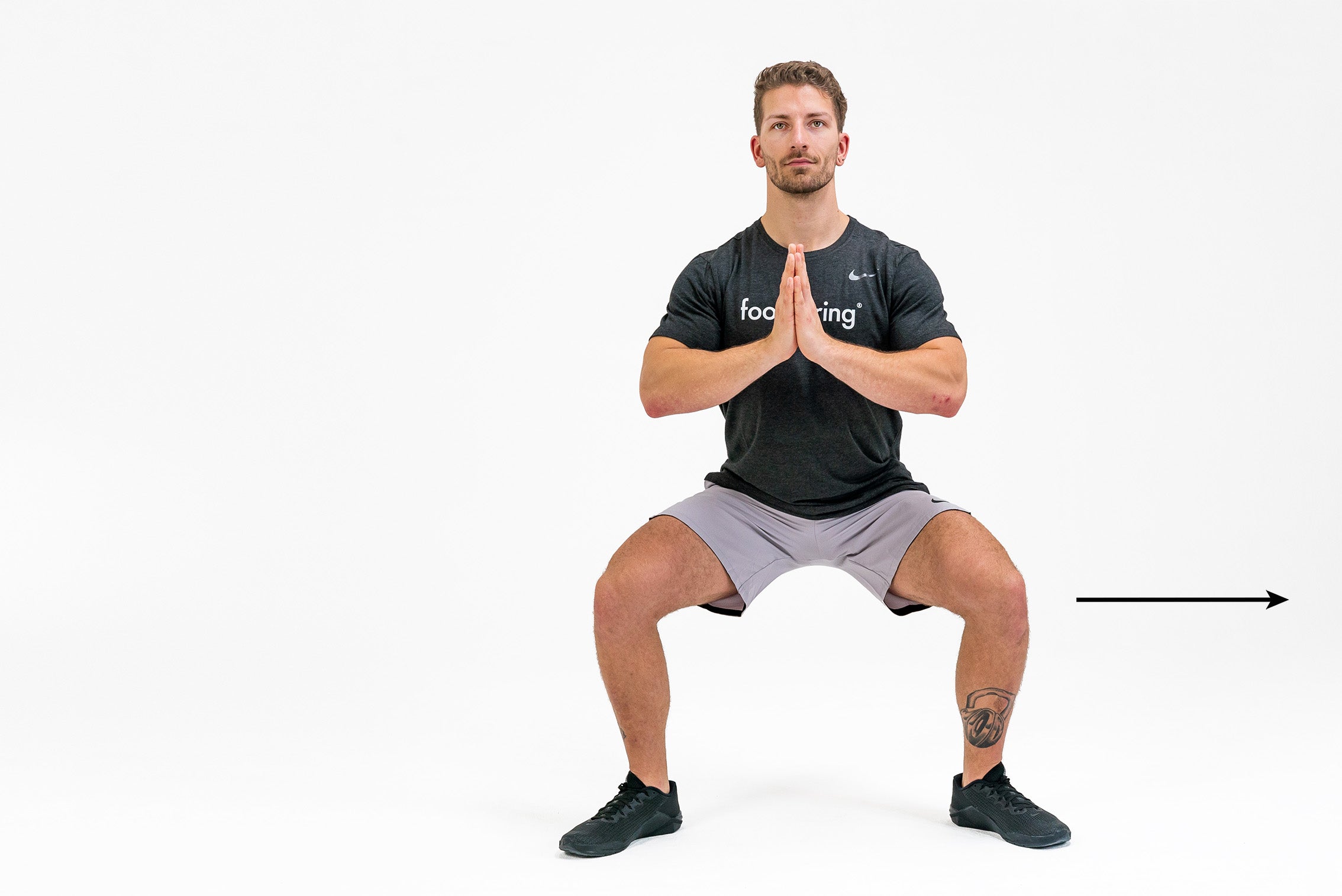
- ©foodspring
Squat Bicycle Crunches:
Squat bicycle crunches are combination exercises with a squat and bicycle crunch in one so they make your abs burn even more! Starting position is, once again, a normal air squat. But this time your hands are behind your head, as in a normal bicycle crunch. For a squat bicycle crunch, after coming up from the squat, your left elbow and right knee meet in front of your torso. Then you go back into the squat and alternate, so when you come back up, you touch your right elbow to your left knee. The one-legged stance helps increase your balance and coordination.
Jumping Squats:
Squat jumps, or jumping squats, are plyometric exercises. Plyometrics is a kind of strength training designed to improve explosive strength. In this kind of strength training, dynamic movements are used to perform reactive bounce training. Jumping air squats are one of its foundational exercises. Not only are speed and jumping power improved, but also coordination, strength, and the cardiovascular system, and you’re burning fat at full speed. The starting position is a normal air squat. From the lowest position you jump up straight like an explosion. As you stretch out into the air, use your arms to swing and balance. You then land in a smooth transition from one air squat to the next. This exercise should only be used if tension can be maintained, especially in your knees and lower back.
Squats with Equipment
The most popular variants are squats that use all kinds of aids, weights, and mats, especially those using a barbell, dumbbells, or kettlebells in different positions:
- Back Squats
- Front Squats
- Overhead Squats
- Sumo Squats
- Pause Squats
- Goblet Squats
- Bulgarian Split Squats
Sources for this article
We at foodspring use only high-quality sources, including peer-reviewed studies, to support the facts within our articles. Read our editorial policy to learn more about how we fact-check and keep our content accurate, reliable, and trustworthy.































